2009 National Survey on Drug Use and Health Highlights
The National Survey on Drug Use and Health (NSDUH) is the primary source of information on the prevalence, patterns, and consequences of substance abuse among people age 12 and older. The survey is conducted every year by the Substance Abuse and Mental Health Services Administration (SAMHSA).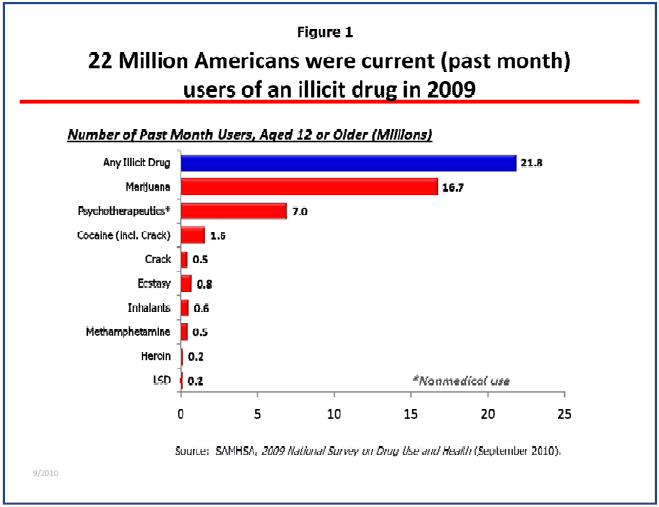
The 2009 NSDUH, released September 16, 2010, shows that drug use in the United States increased in 2009, reversing downward trends since 2002.*
As shown in figure 1, an estimated 21.8 million Americans (8.7%) aged 12 or older were current (past month) users of illicit drugs in 2009, meaning they used an illicit drug within the month before taking the survey. This is an increase of 9% from 20.1 million in 2008 (8.0%). These trends are disappointing, but not unexpected. NSDUH data from the past two years showed that young people’s negative attitudes about drugs, particularly marijuana, were softening. Historical data show that such softening of attitudes typically signals future increases in use.
In 2009, NSDUH documented increases in the category “Any illicit drug” in the past month, and in these specific categories:
- Prescription Drugs
- Marijuana
- MDMA (Ecstasy)
- Methamphetamine
A notable exception was cocaine, which, compared to 2007, showed declines in a number of categories, including current use and the number of new users in the past year.
Prescription Pain Relievers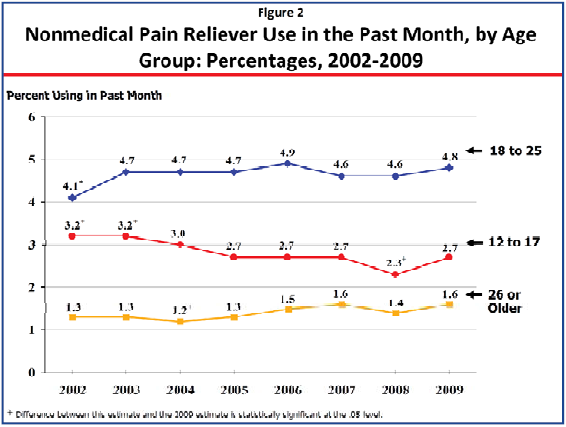
- Ages 12 and older: The 2009 estimate of 5.3 million current nonmedical users is up 20% from the 2002 estimate of 4.4 million.
- Ages 12-17: The rate of current nonmedical use increased 17%, from 2.3% to 2.7% (figure 2).
- Initiation. As a class of drugs, the nonmedical use of prescription drugs continues to have more new users in the past year than any other class. In 2009, there were 2.6 million new users, 2.2 million of which were for nonmedical use of pain relievers.
Possible Reasons
- Most young people who misuse prescription medications report that they obtain the drugs from friends or family. Many of these medications, particularly prescription painkillers, sit unused and unsecured in medicine cabinets, thereby making them readily available.
- Unfortunately, young people often mistakenly think these drugs are safer than so-called street drugs.
Marijuana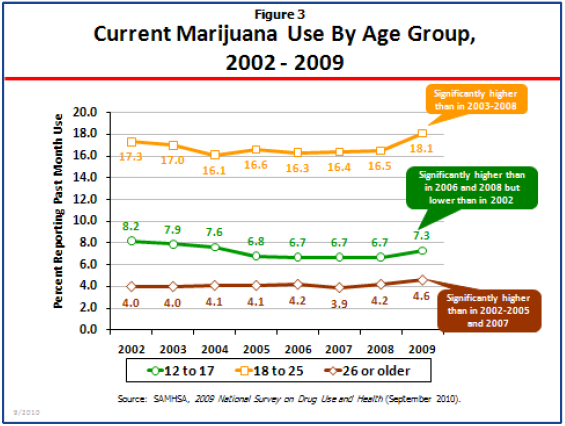
- Ages 12 and older: Of the 21.8 million Americans aged 12 or older who were current users of illicit drugs in 2009, 16.7 million (77%) were current users of marijuana, making it the most commonly used illicit drug. In 2009, 6.6% of the U.S. population were current users, an increase of 8% over 2008.
- Ages 12-17: The increase in the “Any illicit drug” category was driven by a 9.0% increase in current use of marijuana (from 6.7% to 7.3%), as shown in figure 3.
- Ages 18-25: The increase in the “Any illicit drug” category was driven by a 10% increase in current marijuana use, which rose from 16.5% in 2008 to 18.1% in 2009 (figure 3).
- Ages 26 and older: While stable between 2008 and 2009, current use increased 18% between 2007 and 2009 (from 3.9% to 4.6%), as shown in figure 3.
- Initiation. In 2009, there were 2.4 million new past-year users. The average age of initiation dropped from 17.8 in 2008 to 17.0 in 2009.
-
Treatment Access. Compared with 2008, there was a significant increase in marijuana treatment admissions for persons age 12 and older.

Attitudes
- The perception of great risk in using marijuana either “once a month” or “once or twice a week” declined 9% and 7%, respectively, from 2008 to 2009 (see figure 4).
Possible Reasons
- Fueled by discussions of legalization, so-called “medical” marijuana, and a proliferation of pro-drug messages in the media and popular culture, young people are misinformed about a drug whose potency has tripled in the past 20 years and sends more youth to treatment than any other drug.
Because marijuana use is consistently linked with lower grades, higher dropout rates, higher rates of illness, and increasing emergency room and treatment admissions, the Administration is determined to reverse this trend.
Other Drugs
Methamphetamine
- The number of Americans age 12 and older who were current users rose 60% from 2008 to 2009 (figure 5).
MDMA (Ecstasy)
- The 2009 estimate (760,000) of the number of current users is the peak for the 8-year period 2002-2009 (figure 5).
Cocaine
- Current use among 18- to 25-year-olds declined 18% from 2007 (figure 6).
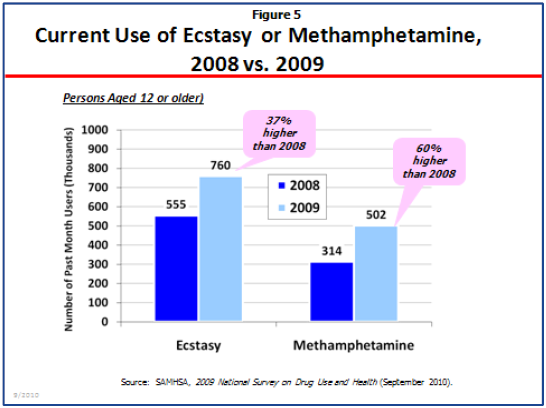
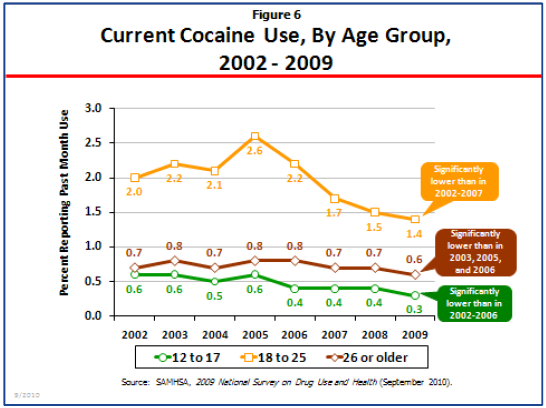
Drugs and Grades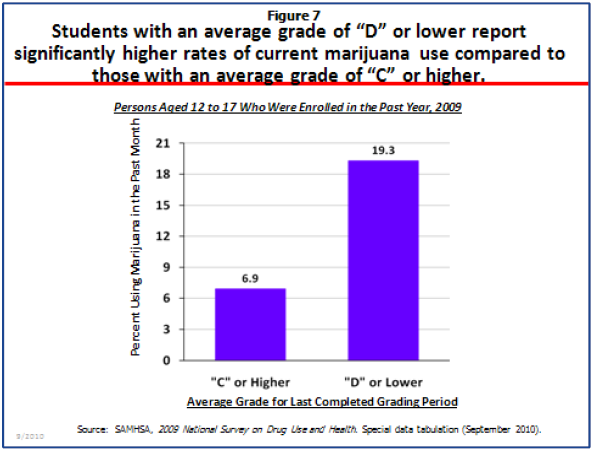
Students who receive average grades of “D” or lower in school are much more likely to use marijuana than those with grades of “C” or above (figure 7).
Administration Strategy
The Obama Administration’s 2010 National Drug Control Strategy comprises a broad range of initiatives for reducing drug use and sets two goals to be attained by 2015:
- Curtail illicit drug consumption in America, including a 15% reduction in current drug use among 12- to 17-year-olds.
- Improve the public health and public safety of the American people by reducing the consequences of drug abuse.
To combat drug use, especially among teens and young adults, our Strategy calls for partnering with communities across the Nation to prevent drug use from starting in the first place, intervening during the first sign of trouble, treating those with serious addictions, supporting those in recovery, and partnering with law enforcement. To this end, President Obama has called for a 13.4% increase in funding for prevention and a 3.7% increase for treatment.
We know from another national survey that more than six out of ten 12th graders who report not using marijuana say they don’t because their parents would disapprove. Teens believe they have valuable things to say, so when a parent genuinely listens, it helps build self-esteem, confidence, and trust. The more parents communicate, the more comfortable their teens will feel about discussing drugs and other sensitive issues.
Community ownership of local drug problems and community involvement in preventing drug use are critical components of the effort to prevent drug use nationwide.
A key objective of two ONDCP initiatives, the National Youth Anti-Drug Media Campaign and the Drug Free Communities program (DFC), is to give adult influencers – parents, coaches, teachers, and others – the tools they need to keep youth drug free. Based on the national evaluation of the Program, we know that DFC-funded communities are succeeding at significantly reducing youth alcohol, tobacco, and marijuana use. Communities are encouraged to take advantage of the abundant resources provided by the Media Campaign. Through the Campaign’s website, www.TheAntidrug.com/resources, communities can partner with ONDCP in delivering sciencebased information to young people on the dangers of drug use, and in promoting influences that have a positive impact on children’s lives.
The Administration’s Strategy rests on building drug prevention coalitions, in partnership with multiple sectors of the community, to reduce the risk factors that contribute to initiation of drug use, address drug use in the health and criminal justice systems, treat substance use disorders, enforce anti-drug laws, and build international partnerships. Together with countless communities across the Nation, we are implementing this comprehensive
Strategy. We are confident this action in our communities, our homes, and in our daily lives will make a difference.
Download PDF
